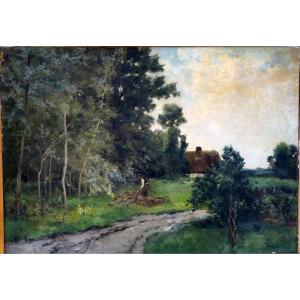A superb and very large 17th century oil on canvas painting by a follower of Claude Le Lorrain, one of the greatest masters of classical landscape painting. This work, entitled Landscape with Aeneas on Delos, is a remarkable reproduction of the original painting in the National Gallery. It reproduces the entire composition with astonishing accuracy, capturing the beauty and harmony of the classical landscape.
Dimensions:
Canvas: 138 x 100 cm
Framed: 158 x 118 cm
Characteristics:
Condition: The work is presented in a beautiful state of conservation, with vivid colours and a fine network of craquelure, typical of the period, which adds to its authenticity and charm.
Restoration: The canvas has been lined to ensure durability, and there has been rare overpainting (less than 0.02%), making this painting even more valuable to discerning collectors.
Frame: The work is beautifully presented in a gilded wooden frame dating from the 1950s, which gives it an aura of prestige and highlights the grandeur of the landscape depicted.
Details and Authenticity:
This painting has a few additional elements that are not present in the original work, which suggests that it could be a special order or an alternative version made at the same time. A sketch of a signature on the low wall reinforces the idea that this is a unique piece, offering a different perspective on Claude Lorrain's masterpiece.
History:
Claude Lorrain (1600-1682), whose real name is Claude Gellée, is considered one of the greatest representatives of the classical landscape. His works are recognized for their masterful treatment of light and their balanced composition, characteristics that are fully reflected in this piece.
Shipping:
Careful and secure shipping, with professional packaging to guarantee the safety and preservation of the work during transport.
Claude Lorrain (1600-1682), whose real name was Claude Gellée, is considered the most eminent representative of the classical landscape. Generally, his landscapes serve as a setting for a biblical, mythological or historical scene, but the characters do not occupy an important place; they represent the anecdote of the painting. Stylistically, they are indeed landscapes with a few small characters in the foreground justifying the imposed theme. But the important thing is the skies, the trees, the sea, the buildings.
Landscape with Aeneas on Delos is the first of the six paintings that Claude Lorrain devoted to the legend of Aeneas in the last ten years of his life.
Patrick AULNAS of "Bohemian Shore" Copyright:
This composition constitutes one of the most accomplished examples of the French classical landscape, heir to the ideal Italian landscape initiated by the Carracci. For the classics, the art of landscape painting is a bit like the French garden: it is about domesticating nature to extract an ideal of beauty, the quintessence of what it can provide in the aesthetic domain. Several characteristics allow us to situate this classical art. Drawing plays an essential role, the contours are apparent and the touch is perfectly smoothed. Claude Lorrain first makes sketches of his landscapes before giving them their final form. The characters are similar to ancient statues as we see here with the majestic poses of the four heroes. The colors must not be aggressive. Violent contrasts are prohibited. In Aeneas on Delos, the blue of the sea and the milky blue of the cloudy sky contrast with the ochre of the earth and the grayish white of the buildings. But no pure color (red or yellow for example) appears. Aeneas' orange tunic is the only small, slightly bright element, so as to distinguish the ancient hero. The search for aesthetic perfection can only be found for the classics in elegance and a certain discretion. They are thus opposed to the baroque painters who use color as an expression of passions.
The treatment of light is a strong point of classical painting. Claude Lorrain is universally known for his ability to illuminate a landscape by capturing the most subtle nuances of morning light or the setting sun. The vast panorama of Delos is illuminated by a soft light passing through the clouds. Using an atmospheric perspective effect (the sky gradually lightens towards the horizon), Lorrain creates a backlight: the light seems to come from the depths of the painting. The dark foreground, with light effects on the brown earth, contrasts with the very light background gradually turning white as it approaches the horizon.
The classical composition seeks a balance that is considered to be the pictorial translation of an ideal of beauty. In this case, the balance is not achieved






























 Le Magazine de PROANTIC
Le Magazine de PROANTIC TRÉSORS Magazine
TRÉSORS Magazine Rivista Artiquariato
Rivista Artiquariato
